Plain bread in two hours
 How dumb could I be? How dumb could I be? It was staring me in the face and I did not notice it. If you had been reading my previous articles on how to make plain bread rise more you would know that somewhere along the line my brain got disengaged. I’m still smarting from my stupidity.
How dumb could I be? How dumb could I be? It was staring me in the face and I did not notice it. If you had been reading my previous articles on how to make plain bread rise more you would know that somewhere along the line my brain got disengaged. I’m still smarting from my stupidity.
I finally figured it out and succeeded in making plain bread within two hours from the time I began to weigh the flour until taking the baked plain bread out of the oven. Sure the plain bread can do with a little bit of improvement but it is nice to eat though. Oh, that picture you see on the left was taken while my brain was still partially disengaged – I had eaten some of the plain bread before I remembered that I wanted to photograph it.
Plain Bread rises more using simple kitchen technology
If you had been following my progress with plain bread making, you would know that I am using the Batter and Dough Method that does not require a bread making machine nor do you have to knead the bread. I was running experiments to get the plain bread to rise a lot more and quickly. I didn’t want to use any chemicals and ended up experimenting with sugar, glucose, gluten, yeast and water temperature combinations.
I was always taught to use cold water ie water straight out of the fridge. This really really slows down the yeast and hence slows down the rate at which plain bread will rise. I wanted to make plain bread rise quickly so I began experimenting with room temperature water. Room temperature in Malaysia, according to my thermometer, is around 28C (82.4F) to 30C (86F). The rate of gas creation was unbelievable. I was adding more and more gluten into the dough to strength the dough so that no tunnels or holes would form to allow the trapped gases to escape from the plain bread dough.
Do note: don’t use tap water as the chlorine content may be too high for the yeast to survive. I have always used boiled water that has been cooled in the fridge.
I got to the point where I was questioning my own creditability and capability of making bread and then it occurred. The light bulb in the sky lit up and I had this vision of a thick batter sucking my brains out. … what is the use of brains when they are not working.
If you remember when I invented the Batter and Dough Method I had used a batter to quickly bring out the gluten so that kneading was not necessary. I was soaking 10% of the bread flour in water ot bring out the gluten and found out that soaking for more than 30 minutes causes the bread to have a very rough mouth feel. Instead of adding more gluten into the bread flour I tried increasing the flour for the batter and reducing the soak time. Hence I soaked 20% of the flour for 20 minutes so that more gluten would form but they had insufficient time to form longer polymer chains. This increased the gluten content without forming longer gluten chains. … and it worked beautifully.
Plain bread quick rise recipe for the Batter and Dough method
| Plain Bread Recipe | ||||
| Item | Ingredients | Percentage | Weight | Weight |
| (%) | (g) | oz. | ||
| 1 | Bread Flour for Batter | 20 | 80.00 | 2.82 |
| 2 | Bread Flour for Dough | 80 | 320.00 | 11.26 |
| Subtotal | 100 | 400 | 14.08 | |
| Batter | ||||
| 3 | Room Temperature water | 60 | 240.00 | 8.45 |
| 4 | Sugar | 6 | 24.00 | 0.84 |
| 5 | Instant Yeast | 2 | 8.00 | 0.28 |
| Dough | ||||
| 6 | Salt | 2 | 8.00 | 0.28 |
| 7 | Ghee / Butter | 7 | 28.00 | 0.99 |
You will notice that I am using ghee (clarified butter) instead of butter. The simple reason is that when I think of making bread I can’t wait for the butter (straight from the fridge) to thaw out and soften. You will notice that I have increased the salt content. I found that I needed to increase the salt content as ghee is not salted and I suspect that additional gluten requires additional salt.
Photos of plain bread recipe and process with the Batter and Dough method
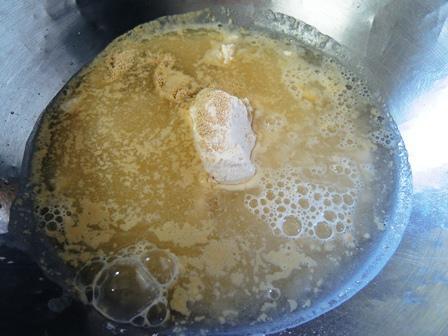
Add the ingredients, 20% bread flour, yeast, sugar, luke warm water, for the batter into a mixing bowl.
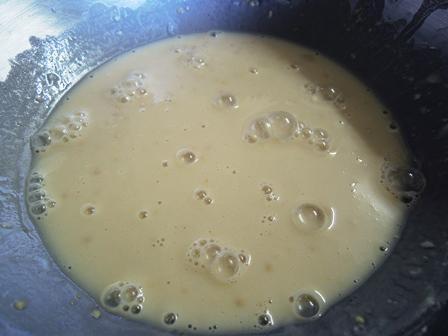
Whisk them for a few seconds to ensure the yeast, flour and sugar are distributed uniformly in the water.
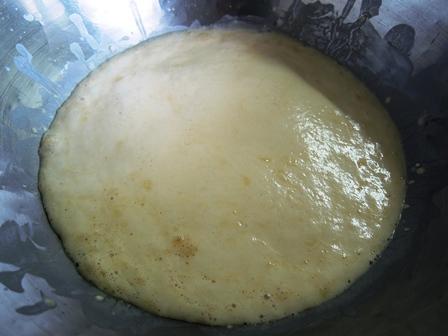
Allow the batter to rest for 20 minutes. It just begins to foam.
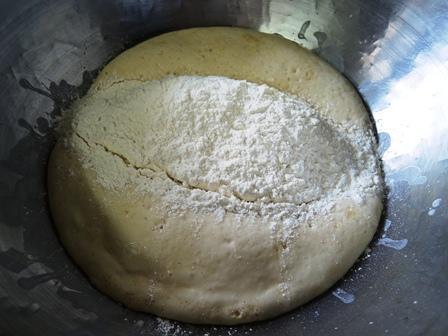
Add the rest of the flour and salt to make the dough. Then mix.
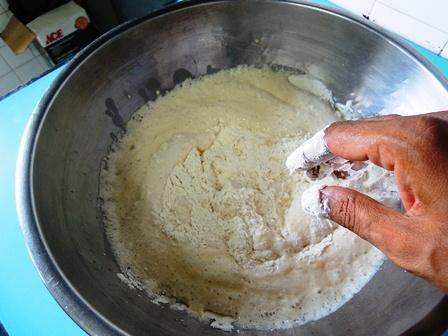
Mix just enough so that most of the flour is in the batter and then add the ghee (or butter).
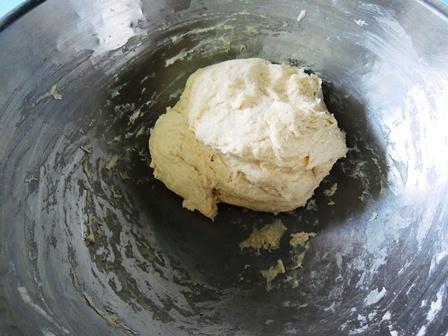
It should form a ball if you fold and press down on the dough about 5 to 20 times. This dough feels much better than my previous experiments.
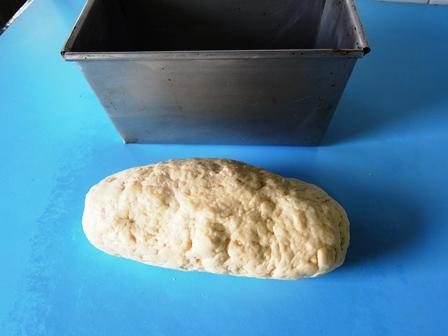
I rolled the dough, for a few seconds, on the work surface as I wanted the top of the bread to be smooth when baked. You don’t need to do this. Just dump the dough into the baking tin for proofing.
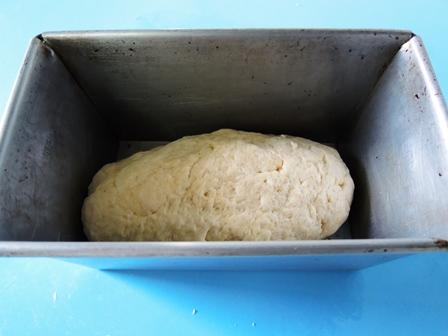
This is the dough size at the start of proofing.
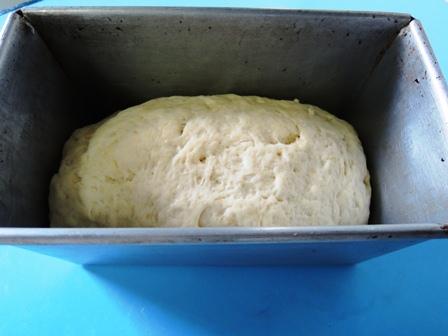
As you can see just in 10 minutes the bread is rising.
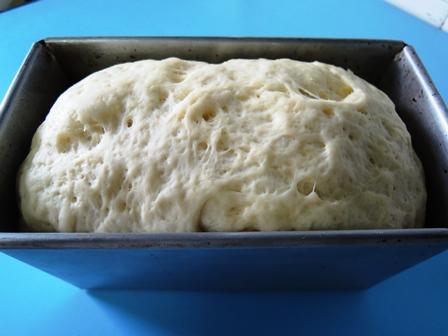
After 30 minutes of proofing the plain bread has risen above the top of the baking tin. You could bake the bread at this stage.
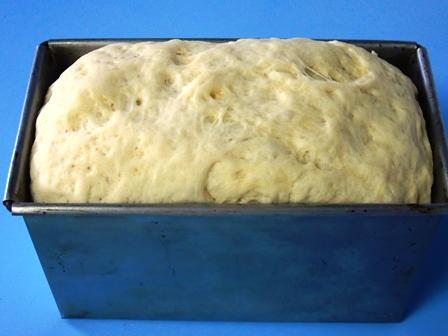
I waited one hour for the plain bread dough to proof as I wanted all the sugar to be consumed by the yeast.
The final Plain Bread fit for a King
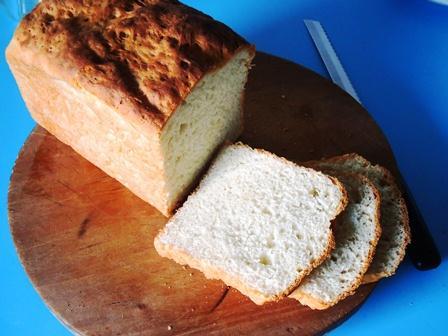
Not bad. This is quite nice sliced plain bread.
You can make some adjustments to this plain bread recipe. Firstly, use unsalted butter instead of ghee and the bread would be tastier. Secondly if you want the plain bread to rise more quickly, try using 2.5% to 3% yeast. I have not tried it out but my guess is that you might get the dough to rise in 30 to 40 minutes instead of an hour – all the sugar being consumed by a larger amount of yeast.
This article on How to make plain bread in two hours batter and dough method was researched and written by Peter Achutha
Leave a Reply